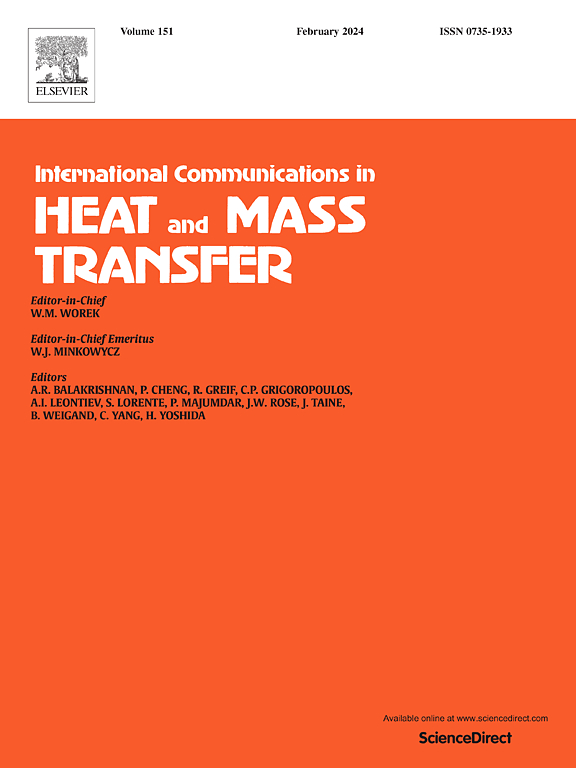烧结粉末芯层平板脉动热管传热流动特性的可视化分析
IF 6.4
2区 工程技术
Q1 MECHANICS
International Communications in Heat and Mass Transfer
Pub Date : 2025-07-21
DOI:10.1016/j.icheatmasstransfer.2025.109326
引用次数: 0
摘要
在本研究中,提出了一种利用烧结粉末芯在通道壁和底部的平板脉动热管(FPPHP)。利用可视化技术,分析了具有烧结粉芯和光滑通道的FPPHP的气液流态演变、准稳态流动模式和传热性能。并通过对比,总结了烧结粉芯对FPPHPs热流动力特性的影响。结果表明:两种FPPHPs的气液流型均以气泡流、段塞流、环空流为主,并伴有气泡流向段塞流的过渡;在垂直方向下,FPPHPs的准定常流动模式包括停滞(S)、间歇脉动(S&;P)和小脉动/大脉动(P)。这些模式伴随着各种气液流动行为,如气泡的生长和聚集、气泡与段塞的结合以及长段段塞的破碎。在不同填充率下,烧结粉末芯对FPPHP启动后的热阻均低于光滑通道的热阻,说明引入毛细芯对FPPHP的传热有有益影响。本文章由计算机程序翻译,如有差异,请以英文原文为准。
Visualization analysis of heat transfer and flow behavior in flat-plate pulsating heat pipe with sintered powder wick layer
Within this work, a flat-plate pulsating heat pipe (FPPHP) utilizing sintered powder wicks on both the channel walls and bottom was proposed. Using visualization techniques, the vapor-liquid flow pattern evolution, quasi-steady flow motion modes, and heat transfer performance of the FPPHP with sintered powder wicks as well as a FPPHP with smooth channels were analyzed. And more, through comparison, the influence of the sintered powder wicks on the thermo-hydrodynamic characteristics of the FPPHPs was summarized. Results indicate that the vapor-liquid flow patterns existing in both FPPHPs predominantly consist of bubbly flow, slug flow, annular flow, along with the transitional flow from bubbly to slug flow. Under vertical orientation, the quasi-steady flow motion modes of the FPPHPs include stagnation (S), intermittent pulsation (S&P), and small pulsations/large pulsations (P). These modes are accompanied by various vapor-liquid flow behaviors, such as bubble growth and aggregation, the coalescence between bubbles and slugs, and the fragmentation of extended slugs. After start-up, the thermal resistance of the FPPHP with sintered powder wicks is lower than that with smooth channels under different filling ratios, which demonstrates the beneficial influence of introducing capillary wicks on heat transfer of FPPHP.
求助全文
通过发布文献求助,成功后即可免费获取论文全文。
去求助
来源期刊
CiteScore
11.00
自引率
10.00%
发文量
648
审稿时长
32 days
期刊介绍:
International Communications in Heat and Mass Transfer serves as a world forum for the rapid dissemination of new ideas, new measurement techniques, preliminary findings of ongoing investigations, discussions, and criticisms in the field of heat and mass transfer. Two types of manuscript will be considered for publication: communications (short reports of new work or discussions of work which has already been published) and summaries (abstracts of reports, theses or manuscripts which are too long for publication in full). Together with its companion publication, International Journal of Heat and Mass Transfer, with which it shares the same Board of Editors, this journal is read by research workers and engineers throughout the world.

 求助内容:
求助内容: 应助结果提醒方式:
应助结果提醒方式:


